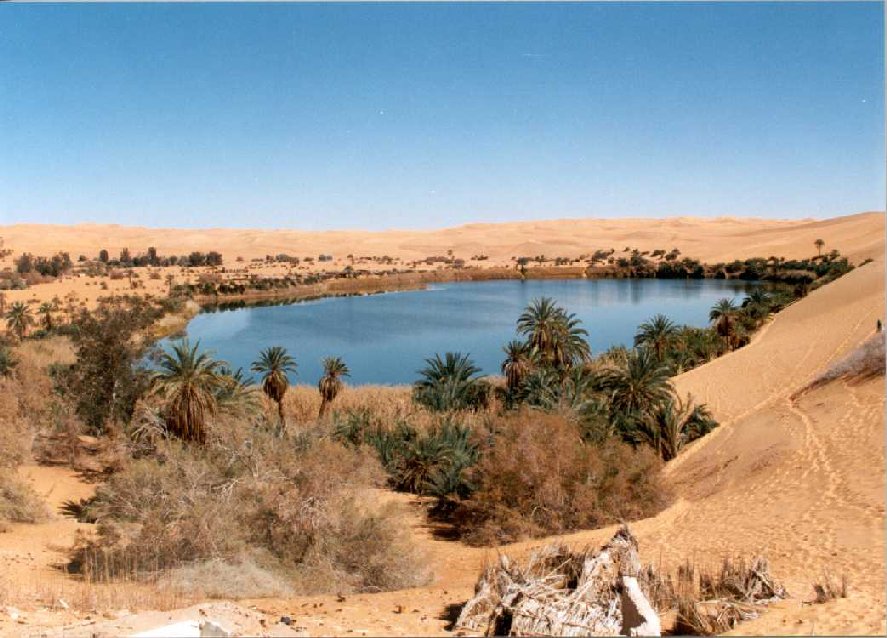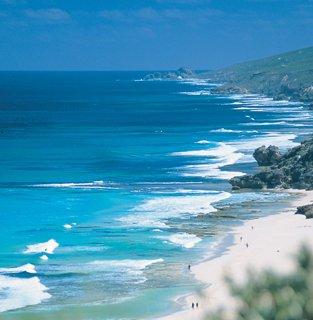The Four Environments of the Arabian Peninsula Most of the Arabian Peninsula is covered by desert. Besides the sand the desert also includes plains and plateaus. The desert is hot, dry, barren, and very harsh. The summer
temperatures often rise above 120 degrees Fahrenheit. In the winter the
temperatures can go below freezing. Many Arabs in the sixth century lived in towns, but many were also nomads. Arab nomads called Bedouins.Bedouins clothed themselves in loose fitting long gowns and cotton
headdresses to protect themselves against dust, heat, and flies. Many people in the desert such as Arab traders used camels to carry goods through the desert in caravans. migrated through the desert raising many animals such as sheep, goats, and camels. The
An Oases occurs in areas where water had been trapped under the ground. The
water seeps to the surface as a spring or as a waterhole. Many farmers bartered, or traded their crops for the goods the nomads brought like milk, meat, and camel
hair. For many centuries nomads traveled from oasis to oasis in search for food and water. Later on they realized that they could grow crops at the oasis, and some nomads gave up wandering around and they became sedentary. They used palm trees to build houses. Arabia's coastal plain ranges from 5 and 40 miles inland. It ends at a series of rocky cliffs. In the Coastal Plain the air is damp and moist with some rain falls. People built deep wells, dams, and systems to irrigate the land. They also used sea trade to travel and trade with other places. The Arabian Mountains rise from l,000 to 12,000 feet high. Moist winds from the Indian Ocean bring as much as 20 inches of rain. In the winter frost may also form. In the sixth century many people lived in the Asir Mountains. These people farmed on the steep slopes by creating terraces, or flat areas. They also made their houses out of mud bricks. The four Vegetation Zones of Africa Desert- The desert is sandy, hot, and dry. The biggest desert in Africa is called the Sahara Desert. This desert is located mostly in North Africa, but is also in West Africa. The Sahara desert was very difficult to travel across so not many people tried too. Two factors spurred the growth of the Trans- Saharan trade. The first was the introduction of camels, and the second was the spread of Islam. Semi Desert- The semi desert is somewhat dry and contains grasses and scrubs. The semi desert is located in East Africa, West Africa, South and Central Africa, and a little bit in North Africa. In West Africa this zone is called Sahel. Savanna- A savanna is grassland that consists of tall grasses and scattered trees. The savanna is located in North Africa, West Africa, South and Central Africa, and a little bit in East Africa. A savanna is usually found between rain forests and deserts. Savanna's don't get enough rain fall to support forests. They usually have warm temperatures all year round. The Niger River extends into the forest zone in the southern part of West Africa. This zone is even wetter than the savanna. Rain Forest- The rain forests have the most abundant vegetation. They are able to plant and grow the most crops in this type of zone. The rain forest is located in North Africa, West Africa, South and Central Africa, and a little bit in East Africa. This type of zone consists mainly of tall trees at a warm temperature year round. Traders from the north crossed the Sahara Desert with salt, copper, and cowrie shells. They traded these goods for kola nuts, hides, leather goods, ivory, slaves, and gold from the southern forests. Kumbi located in West Africa, had one of the largest slave markets. Many items were traded between North Africa and the southern forests, but the two main kinds were gold and salt. Many North Africans wanted gold which came from Ghana, while the people in the forests wanted salt which comes from the Sahara. Ghana made most of its money from the taxes it charged on the gold-state trade which passed through the land. Wangara is an area were gold was plentiful. No one knew exactly where the gold mines were located except for the people of Wangara. The trade with the people of Wangara took place along the river. They did this by using the silent barter system. This allowed them to trade with other cultures who might have spoken a different language, and it helped the Wangara's guard their secret gold mines. A city called Taghaza was famous for its salt. They used salt for many reasons, such as to preserve food, and to replace the salt they lose when they sweat.  |
||||
 |
||||